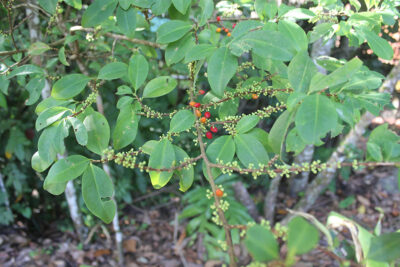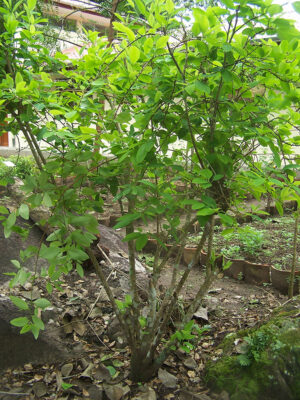
Coca plant with fruits
Takiwasi, CC BY-SA 4.0, via Wikimedia Commons
Often misunderstood, the coca plant, holds a profound place in the traditions of indigenous Andean communities for millennia. Beyond its notorious association, this plant’s leaves offer mild stimulant properties when chewed or brewed, playing a vital role in spiritual ceremonies, social interactions, and even as a remedy for altitude sickness.
Names
Scientific
Erythroxylum coca
English
Coca
Dutch
Coca
Spanish
Coca
French
Coca
German
Cocastrauch
Italian
Coca
Taxonomy
Order
Malpighiales
Family
Erythroxylaceae
Genus
Erythroxylum
Species
Erythroxylum coca (Coca)
Basic information and facts
Origin:
Native to the Andes mountains of South America, particularly in Peru, Bolivia, Ecuador, and Colombia.
Distribution:
Primarily cultivated in the Andean highlands and Amazonian lowlands of South America. Naturalized or cultivated in some tropical regions outside its native range, though often illegally.
Annual, biennial, or perennial:
Perennial shrub.
Flowers:
Small, yellowish-white flowers, borne in clusters on short stalks in the axils of the leaves. They have five petals and ten stamens.
Leaves:
Oval, thin, opaque, and a bright green color, tapering at the apex.
Fruits:
Small, red, ovoid berries, about 1 cm long, containing a single seed.
Climate and weather:
Prefers tropical and subtropical climates with high humidity and consistent rainfall. Often found growing on mountain slopes at elevations between 500 and 2,000 meters (1,640 to 6,560 feet), though some varieties grow at sea level.
Pollination:
Likely pollinated by insects, though specific pollinators are not widely documented.
Height:
Typically grows as a shrub 2-3 meters (6-10 feet) tall, but can reach up to 5 meters (16 feet) if left untrimmed.
Spacing:
When cultivated, plants are typically spaced 1-2 meters (3-6 feet) apart, depending on the intensity of cultivation.
Propagation:
Primarily propagated by seeds, though vegetative propagation through cuttings is also possible.
Insect pests:
Can be susceptible to various insect pests, including leaf miners, aphids, and various chewing insects. Specific pests vary by region.
Diseases:
Fungal diseases, such as leaf spot and root rot, can affect coca plants, especially in humid conditions. Viral diseases are also a concern in some cultivation areas.
Harvesting:
Leaves are harvested multiple times a year, typically 3-4 times, by carefully plucking them from the branches when they reach maturity and have a distinct green color. The frequency of harvest depends on environmental conditions and cultivation practices.
Uses:
Traditionally, coca leaves are chewed or brewed into an infusion (mate de coca) for their mild stimulant effects, to alleviate hunger, thirst, fatigue, and altitude sickness. They also play a significant role in indigenous spiritual ceremonies and social rituals. Industrially, the leaves are the raw material for the extraction of cocaine, though this is a distinct and processed product. Coca leaves are also used in some food and beverage products (after the cocaine alkaloid is removed), and in traditional medicine for various ailments.
Crop categories
Medicinal plants
Minor crops
Stimulants
Tropical crops
Pictures

Coca plant
Takiwasi, CC BY-SA 4.0, via Wikimedia Commons
